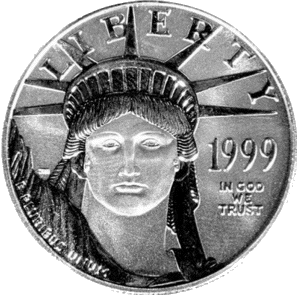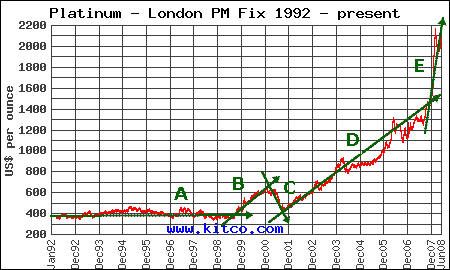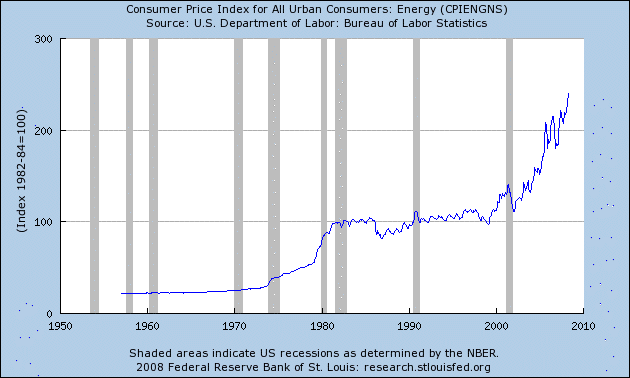 |
Conundrum of the Century: Inflation versus Credit Crunch
The relative simplicity of the platinum market as compared to oil, gold, or silver, makes platinum an ideal context to review commodity prices in general since prices began to rise in 2001 after the post bubble collapse global reflation. Platinum brings currency, inflation, and demand dynamics for all commodities into focus. This review will also inform our opinion on where we are in the Ka-Poom disinflation-reflation cycle, and we'll wrap an update to Ka-Poom Theory around it.
The oft neglected step-child among the precious metals (PM), platinum gets far less attention than its more popular PM cousins gold and silver. It trades differently, too. Gold and silver typically move in lock step while platinum follows its own path.
Platinum, unlike silver and gold, has never had a role as a monetary metal. It has only ever been an industrial metal. Nor is platinum supply influenced by geopolitical or security factors as is oil. More than 90% of platinum production is in Russia and South Africa, nations on more or less friendly terms with the US.
Platinum supply and demand market characteristics are relatively clear: Platinum is the most precious of the precious metals, more than 30 times more rare than gold yet trades at only slightly more than twice the price of gold. While platinum is rare, a little bit goes a long way. Its primary industrial use is in catalytic converters but is also used in pace makers and jewelry.
 |
As an side, I'm often asked why I purchased physical metals then. The answer is simple: no alternatives existed at the time. Gold and silver ETFs were not yet available. Not until PM investment interest grew after several years of price increases did ETFs become viable, and since then ETFs have created their own demand for gold and silver, which explains why gold and silver prices tend to move in lock step: hedge fund trades tied to ETFs. Part of the recent increase in platinum prices was driven by new investor demand created by platinum ETFs, such as PHPT, launched in 2007. ETFs makes commodities available to investors who would never own physical metal, who are more comfortable purchasing PMs as they do stocks out of their brokerage account.
Why not PM mining stocks? I concluded a decade ago, as Jim Rogers and others have, that you cannot get exposure to the value of PMs as a dollar hedge by buying mining company stocks. Stocks expose you to management risk and stock market risk, and long term no one gets it right. I was looking to "buy and forget" for the entire period of dollar depreciation, seven years and counting, not stocks in mining companies that I'd have to actively track.
If I were buying now, would I purchase a gold or silver ETF instead of physical? I'd buy ETFs for the portion of PMs I hold as a hedge against dollar depreciation and physical for the portion of PMs I own to hedge less likely yet more dire potential outcomes of systemic financial system failure.
As of this writing, platinum is trading $1,992, more than four times what I, or anyone following the thesis, paid for it. Should we sell? If we can answer that question then we have answered a lot of questions about commodity prices. To answer this question, let's step through the five distinct pricing periods since 1992 shown as A through E in the chart below and see what we find.
 |
The most controversial and confusing period is the current one, Period E. What drove platinum prices so high so quickly? Clearly not industrial demand. We believe the answer is that sustained weakness in the dollar and the out-sized influence of rising costs of imported energy on all goods prices starting in 2004 led to steadily rising inflation expectations, in turn leading to ever increasing investment demand by funds for an ever widening range of commodities in various forms to protect the purchasing power of wealth. The emergence of platinum ETFs facilitated fund buying of platinum.
Unfortunately, purchases of commodities by funds to hedge inflation caused by a weak currency is self-reinforcing as demand for commodities as a hedge drives up demand for the commodities themselves.
Also complicating the picture, as we cover in detail this week in Anatomy of a collapsing oil anti-bubble: Is oil “too expensive” now or was it “too cheap” before? is the impact of rising energy prices as an input to commodity prices: growing, mining, shipping and otherwise bringing commodities to market is a function of the cost of energy needed to extract, process, and move it. On top of that we have the credit crunch beginning to limit access to capital to fund mining operations, including energy projects. (We were recently invited to an energy conference that featured a seminar on the growing impact of the credit crunch on energy projects; these are mostly debt not equity financed.) It all adds up to one monumental mess of inflation and credit contraction in a feedback loop of falling dollar value, rising prices, falling purchasing power, debt deflation, credit contraction, and a weakening economy, with no clear way out.
While 1999 Ka-Poom Theory served us well to time the purchase of our PM dollar depreciation hedges, it did not take into account six developments we were not able to foresee nine years ago.
Ka-Poom Theory Revisited
The six unexpected developments for the current cycle are:
- As we mention in our About page when we re-launched iTulip March 2006, we did not foresee the housing bubble, believing wrongly that the Fed would never allow one to develop because collapsing property bubbles invariably bring down economies and banking systems. We did begin to write about the bubble in August 2002 and described the collapse dynamics in detail in 2004 and 2005. These forecasts are still holding up, and we will update them in the future. With respect to Ka-Poom Theory, the dynamic of the disinflationary impact of a collapsing housing bubble is a characterized by a gradual versus rapid mark to market of declining property assets. The resulting graduated negative wealth effect and loss of value of collateral against loans allows the Fed to compensate in broader and more varies terms, and less dramatically, than during the 2001 period when the crashing assets were stocks not houses. That caused a near instantaneous and simultaneous mark to market of stock portfolios. This time the effect is more broad and we believe will be far more severe.
As I explained to my publisher at Penguin, if the crashing stock market in 2000 was a monetary 500 pound wrecking ball stopped by emergency rate cuts, the collapsing housing market is a 20 ton steam roller running down everything in its path until it heads for the bottom of the FIRE Economy hill. The process is but slow but inexorable.
- We knew from our readings of Fed intentions as noted in No Deflation! Disinflation then Lots of Inflation years before the credit crisis, and from conference calls such as with Goldman Sachs during the crisis, such as Goldman Sachs Client Call - Analysis, that the Fed was prepared to be "creative" in its effort to avert a self-reinforcing debt and monetary deflation. What we could not have known in 1999 was that the Bernanke Fed was willing to, in the words of Paul Volcker, overstep its legal authority to provide funds, permanently, to financial institutions that the Fed is not chartered to support. This has, so far, prevented a sudden and wholesale collapse of the exogenous credit markets, but also makes them less exogenous and more directly tied to government credit and money creation.
- Currency depreciation is discussed in the central banking theory literature as a short term policy tool to be used in combination with other reflation policies, such as rate cuts, to ward off a deflationary spillover into the real economy of crashing asset prices after the collapse of an asset price bubble. After more than four years of dollar decline, it is apparent that dollar depreciation is the primary tool on which the Fed has come to depend to prevent asset price deflation from spilling over into the Production/Consumption Economy from the financial sectors of the FIRE Economy.
The result of this depreciation has been Poom-like inflation albeit without the large scale sales of dollar denominated assets or a rise in bond yields we expected – at least not yet.
- Willingness of foreign central banks to step in to provide funds sufficient to maintain low Treasury bond yields to compensate for decreased demand from private markets.
- Peak Cheap Oil, that is, the peak, most likely around 2006, of global supply of easily accessible, high grade crude that global refineries are geared to process and that are used for transportation. Combined with the dollar depreciation that we did anticipate and the oil subsidies provided by oil producing and Asian governments, rapidly rising energy prices are also feeding "Poom" inflation. In the current Ka-Poom cycle, we are getting the inflationary result we expected but not from the precise set of causes and processes we anticipated.
- The first "preemptive war" with Iraq War was unimaginable. The result is threefold with respect to Ka-Poom Theory. First, the war reduced US political power in the region such that the quid pro quo exchange of military protection of oil exporting regimes for oil below market prices is less effectual. Second, the global central banking dollar cartel that created artificial demand for dollars has weakened due to competition from the euro and loss of political support from US allies that help support the dollar by purchases of dollar denominated assets and depreciation of their own currencies. Third, the cost of the war has meant that borrowing for unproductive purposes has crowded out productive borrowing by both public and private sectors. This invariable shows up as inflation and lower productivity, as occurred years after the end of the Vietnam War.
Conundrum of the Century
Here's where we are in our updated Ka-Poom cycle in the context of platinum prices:
Period A: Normal industrial demand market – commodity supply and demand dominates
Period B: Asset and goods price inflation – commodity prices respond to inflation
Period C: Asset price deflation and goods price disinflation – commodity prices respond to disinflation
Period D: Dollar depreciated to reflate the economy – commodity prices respond to dollar weakness
Period E: Rising import prices feeds inflation cycle - commodity prices respond to currency hedging investment demand
This does not mean that "Poom" as originally conceived, with a large scale sell-off of dollar denominated assets and spiking interest rates, cannot still happen. At a recent meeting we were told by a hedge fund manager with over $1 billion in his fund and 30 years of experience under his belt that "now" is when Treasuries finally buckle. But the current post-housing bubble disinflationary "Ka" period will continue to be managed via Fed policy to attempt to prevent the transmission of asset price deflation into the real economy. The inflation that results reduces the likelihood of a sustained decline of all-goods and commodities prices. In fact, the ongoing reliance on currency depreciation as the primary policy tool to maintain flagging GDP growth means that inflation may continue to be fed into the system even as the recession progresses. Period B: Asset and goods price inflation – commodity prices respond to inflation
Period C: Asset price deflation and goods price disinflation – commodity prices respond to disinflation
Period D: Dollar depreciated to reflate the economy – commodity prices respond to dollar weakness
Period E: Rising import prices feeds inflation cycle - commodity prices respond to currency hedging investment demand
We expect a leveling off or even a decline in commodity prices in the months ahead as the US credit crunch and recession impact global demand. Declines in some commodity prices over the past few months indicate that the recession is beginning to lower inflation expectations among investors. However, the conundrum of the century remains: inflation expectations cannot be lowered as they were in the early 1980 unless the root cause, a weak dollar pushing up import prices, is addressed dramatically with rate hikes to cause the dollar to appreciate, yet the over-leveraged US financial system is struggling with interest rates near 30 year lows as debt deflation and credit contraction grip the economy and intensify. The one action that the Fed can take to slow inflation is the one action it cannot take without pushing the staggering economy off a cliff into the kind of self-reinforcing debt deflation abyss as the US experienced in the 1930s.
There is no obvious resolution to this conundrum. The most likely event that moves commodity prices is a next step in the financial crisis that forces the Fed to cut rates again. This, it seems to us, is far more probable than a resolution of the dollar crisis by rate hikes that will invariably deepen the recession, especially in an election year when 28 million Americans are already on food stamps, the highest number on record. For this reason, even though platinum prices are showing all the signs of a blow-off top driven by investor fears of further dollar weakness and more inflation, and the recent spike looks precarious, I cannot convince myself that selling is prudent at this time. If indeed more crises events are coming, dollar sentiment is likely to get worse before it gets better. It will pay to stay close to the funds that have been driving the PM market this year to make sure we know what they are thinking, hopefully before they act.
See: Inflation in America - Part I: Five signs of inflation
iTulip Select: The Investment Thesis for the Next Cycle™
__________________________________________________
To receive the iTulip Newsletter or iTulip Alerts, Join our FREE Email Mailing List
Copyright © iTulip, Inc. 1998 - 2007 All Rights Reserved
All information provided "as is" for informational purposes only, not intended for trading purposes or advice. Nothing appearing on this website should be considered a recommendation to buy or to sell any security or related financial instrument. iTulip, Inc. is not liable for any informational errors, incompleteness, or delays, or for any actions taken in reliance on information contained herein. Full Disclaimer



 ), nobody worries if it's really there locked up in a Central Bank vault instead of being lent out to bullion banks, and there's no photographic use or arguments whether that recycled scrap is really new supply or not.
), nobody worries if it's really there locked up in a Central Bank vault instead of being lent out to bullion banks, and there's no photographic use or arguments whether that recycled scrap is really new supply or not.
Comment